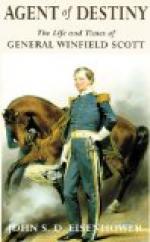General Scott’s mother, Ann, was the daughter of Daniel Mason and Elizabeth Winfield, his wife, who was the daughter of John Winfield, a man of high standing and large wealth. From his mother’s family he acquired his baptismal name of Winfield. John Winfield survived his daughter, and dying intestate, in 1774, Winfield Mason acquired by descent as the eldest male heir (the law of primogeniture then being the law of Virginia) the whole of a landed estate and a portion of the personal property. The principal part of this large inheritance was devised to Winfield Scott, but, the devisee having married again and had issue, the will was abrogated. The wife of Winfield Mason was the daughter of Dr. James Greenway, a near neighbor. He was born in England, near the borders of Scotland, and inherited his father’s trade, that of a weaver. He was ambitious and studious, and giving all of his spare time to study, he became familiar with the Greek, Latin, French, and Italian languages. After his immigration to Virginia he prepared himself for the practice of medicine, and soon acquired a large and lucrative practice. He devoted much of his time to botany, and left a hortus siccus of forty folio volumes, in which he described the more interesting plants of Virginia and North Carolina. He was honored by memberships in several of the learned European societies, and was a correspondent of the celebrated Swedish naturalist Linnaeus. He acquired such a knowledge of music as enabled him to become teacher to his own children.
James Hargrave, a Quaker, was one of young Scott’s earliest teachers. He found his pupil to be a lad of easy excitement and greatly inclined to be belligerent. He tried very hard to tone him down and teach him to govern his temper. On one occasion young Scott, being in Petersburg and passing on a crowded street, found his Quaker teacher, who was a non-combatant, engaged in a dispute with a noted bully. Hargrave was the county surveyor, and this fellow charged him with running a false dividing line. When Scott heard the charge he felled the bully to the ground with one blow of his fist. He recovered and advanced on Scott, when Hargrave placed himself between them and received the blow intended for Scott; but the bully was again knocked to the ground by the strong arm of Scott. Many years afterward (in 1816) Scott met his Quaker friend and former teacher, who said to him: “Friend Winfield, I always told thee not to fight; but as thou wouldst fight, I am glad that thou wert not beaten.”
His next instructor was James Ogilvie, a Scotchman, who was a man of extraordinary endowments and culture. Scott spent a year under his tutelage at Richmond, and entered, in 1805, William and Mary College. Here he gave special attention to the study of civil and international law, besides chemistry, natural and experimental philosophy, and common law. At about the age of nineteen he left William and Mary College and entered the law office of Judge David Robinson in Petersburg as a student.




